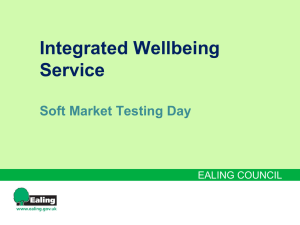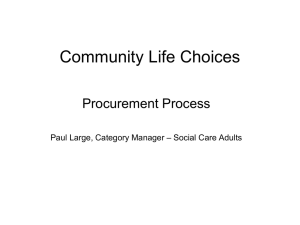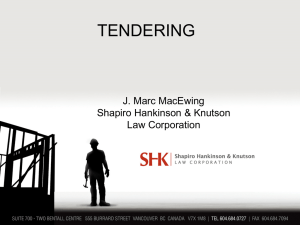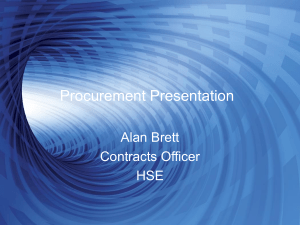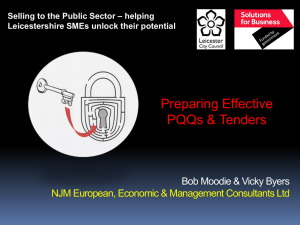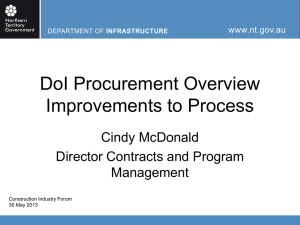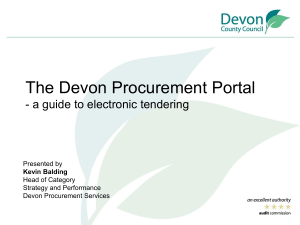Adopting a Strategic Approach in Selling to the Public Sector
advertisement
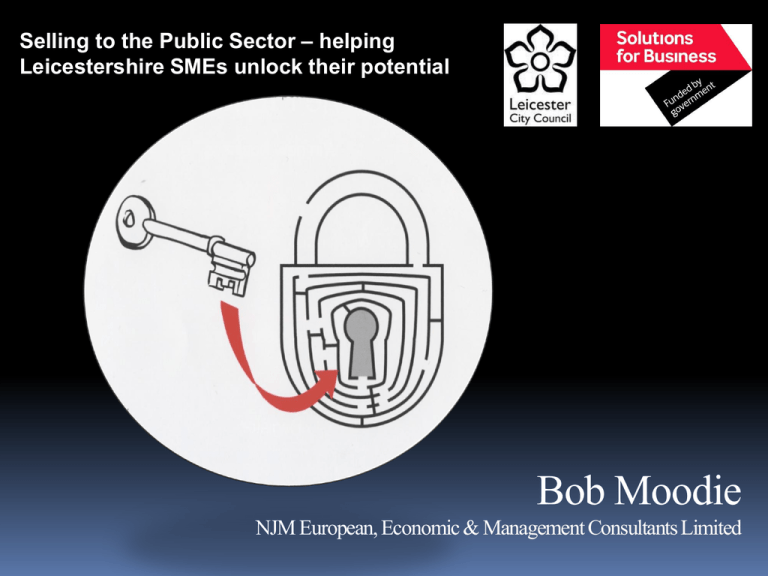
Selling to the Public Sector – helping Leicestershire SMEs unlock their potential Bob Moodie NJM European, Economic & Management Consultants Limited The Challenge No. of Employees % of business stock Composition of business stock 1-9 10-49 50-249 250+ 89.9 8.4 1.4 0.3 99.7% 0.3 SME LSE According to the latest figures only 16% of the total value of public contracts go to SMEs. 75% of SMEs rarely or never bid for public sector work Where to find information/opportunities Preferred suppliers We’re too young (we lack trading history /track record) Lack of previous public sector experience Price We’re too small (contract is too big as a proportion of our turnover) Difficult to access purchasers Lack of bid skills The timescale is too tight Process is time-consuming, costly and complex PQQ qualifiers – policies & procedures Location and point of service Difficult to find consortia to bid with Responding to the Challenge: Be Strategic The Key Themes in Today’s Workshop The Procurement Context Identifying opportunities and raising business profile When to bid and when not to bid Preparing PQQs and tenders In the present competitive environment it is vital to understand that only a very professional approach at all levels of the process will suffice if you want to be successful The Procurement Context: Regulatory Framework EU Procurement Directives European National Government Strategy Statutory Requirements Local Council Procedures Local Agreements EU Procurement Thresholds Supplies Central Government plus some ‘Quangos’ (see Schedule 1 List) Other Public Sector e.g. Local Authorities, Universities, FE, etc Services Works €125,000 €125,000 €4,845,000 (£101,323) (£101,323) (£3,927,260) €193,000 €193,000 €4,845,000 (£156,442) (£156,442) (£3,927,260) Thresholds applicable from 1st of January 2010 and are NET of VAT Principles: Open competition, non-discrimination, equal treatment and transparency. Note: Exchange Rates A New Environment Political Economic The Comprehensive Spending Review (2010) NHS reorganisation Glover Report - SMEs and Public Procurement (2008): Transparency Simplicity, Strategic & Measurement Equality of Access (SME & Third Sector) Coalition Government’s aspiration to award 25% of central contracts to SMEs Price & Value for Money Financial Environment Contract Bundling (Economy of Supply) Rationalisation & Framework Agreements Ability to deliver economies and efficiency savings Social Technological Corporate Social Responsibility Sustainability Innovation & non contractual outcomes Portals E-tendering E-auctions Real time reporting Context & Opportunity Public procurement, estimated at over £175 billion per annum (13% of UK GDP) Leicestershire County Council spends over £300 million each year on goods, works and services. Over the next three to four years, to 2012-13, the Council will need to make savings of around £70m that’s 25% of its budget. Leicester City Council estimated procurement budget for the Authority is £260 million p.a. (20072008). NHS Leicestershire & Rutland Procurement Partnership influences spend of approximately £250 million on goods and services each year. Local Procedures Public Sector Organisation Threshold (goods & supplies) Procurement Process & Source Leicestershire County Council <£1k £1k – £20k >£20k - £100k 1 Oral / Written Quote 3 Written Quotes or www.sourceleicestershire.co.uk Request for Quotation www.sourceleicestershire.co.uk >£100k - EU threshold (£156,442) Formal Tender Process www.sourceleicestershire.co.uk Or www.espo.org < £10k £10k - £49k Oral / Written Quotes (officer discretion) 3 Written Quotes or Formal Tender Process (officer discretion) £50K - EU threshold (£156,442) www.sourceleicestershire.co.uk or www.espo.org Up to £250k (works only) www.exorgroup.co.uk/supplier £5k - £25k >£25k – EU threshold (£156,442) 3 Oral / Written Quotes Formal Tender via departments or www.in-tend.co.uk Leicester City Council University of Leicester Procurement Procedure Procedure Characteristics When the procedure is adopted Open All qualified applicants must be given the opportunity to bid For lower risk procurement where supplier capability is less important or where the focus is on price Restricted Two stage process with facility to shortlist (PQQ + Tender) Where capability of supplier is key determining factor in the delivery of the contract, market response likely to be huge to allow short-listing Negotiated Two stage process with facility to negotiate at second stage Specification is not clear or some creative, artistic or expert input is required. Competitive Dialogue Two stage process with facility to enter into a dialogue with potential suppliers to consider potential solutions and refine specification before invitation to tender Complex procurement where suppliers expertise has significant impact on the development of the specification Framework Agreement Call-Off or Mini competition amongst preferred suppliers (selected from open/restricted procedure) Capability and Capacity is important and is generally a recurring/constant requirement (max 4 years; including extension options) Procurement Process Overview Procure Contract Notice EOI Tender Commission Review PQQ Manage Award Evaluate Contract Notices KEY TENDER WEBSITES Name: Source: Used by: Eastern Shires Purchasing Organisation www.espo.org LAs, NHS in Leicestershire, OJEU tenders Source Leicestershire www.sourceleicestershire.co.uk LAs, NHS in Leicestershire Leicestershire County & http://www.lcr.nhs.uk Rutland NHS NHS In-Tend www.in-tend.co.uk Universities, Colleges, Schools, LAs (some in Leicestershire and nationally) Blue Light www.blpd.gov.uk Police, Fire & Rescue Services (including Leicestershire Constabulary & across UK) Supply to Government www.supply2.gov.uk www.supply2health.nhs.uk Lower value government tenders (*website will be replaced by ‘Contracts Finder’ March 2011) OJEU www.ted.europa.eu Any public sector contract above EU Threshold A Strategic Approach Identifying Opportunities & Raising Your Profile Be Systematic & Get Organised What is your target market? In your target market who are the key buyers - Personnel at Department level and Procurement Officers (important for low value contracts that are not formally advertised)? Engage procurement personnel - make sure they know you exist, seed ideas Find out about approved (accredited) supplier lists Register and publish on tender e-portals Network (buyers/commissioners, meet the buyer events) Be Systematic & Get Organised Set up internal processes and individual(s) to monitor tender portals, alerts, sources and review feedback Search for potential business partners / collaborators / subcontractors Develop / improve your key policies e.g. Make them relevant and articulating business benefit Accreditation (e.g. CHAS, ISO, IiP etc) Bid writing is a skill – invest the time in developing the capability A Strategic Approach To bid or not to bid? Strategic Decision Making Is the tender a good fit in relation to your company’s activities? Can you meet the eligibility criteria (technical qualifications, policy compliance e.g. Quality Assurance, Insurance) ? Do you have a good track record in relation to the opportunity? Do you have the trading history (e.g. 2 years Accounts)? Do you have the capability and capacity to deliver the contract if successful? Can you make sense of the budget and can you deliver the contract on time? Strategic Decision Making What are the risks? Who are your competitors? What percentage of your turnover does the contract represent? Do you need a partner(s) or will you use subcontractors? What is the percentage chance of success? Do you have the time and resources to devote to preparing a good bid? Strategic Decision Making Solo or Collaborative Bidding? Form a consortium if: You don’t have the capability or capacity You can’t meet the 20% rule Options: Consortium Joint Bidding Lead Contractor & Subcontractor Legal basics Memorandum of understanding (MoU) / Partnership agreement / (Non Disclosure agreement (NDA); Agreement not to compete in other tender) Service level agreement (SLA)/contract Consortia Benefits: Risks: Increase capacity and scope to bid e.g. Overcome PQQ impediments Partner selection and getting Agreement Shared trade history (combined capability and capacity) Trust relationship (how well do you know your partner – can you be confident they can and will deliver) Business Development: Access new clients and markets Complex decision-making, loss of autonomy, compromises and concessions Spread risk Sharing sensitive information Mutual learning and innovative approaches Logistics (Co-ordinating bid) Delivered additional added value (the Logistics (Contract delivery) whole is greater than the sum of the parts) Improve chance of success A Strategic Approach Preparing the Bid Preparing the PQQ/Tender Make sure you download/print off ALL tender documents and read them carefully (multiple times) Note the tender instructions, e.g. word limits, submission format, deadlines and evaluation criteria PQQ: Example Scoring Framework Section Score Weighting 1 Organisation Details N/A 2 Financial Information N/A or Risk Based Assessment Pass/Fail 3 Insurance 4 Business Activities 15% 5 Business Practices 30% (Total) Pass/Fail Health & Safety 5-10% Quality Assurance 5-10% Environmental Management 5-10% Equality 5-10% 6 Requirement - specific 40% 7 Experience & References 15% 8 Professional & Business Standing Pass/Fail Tenders: Example ‘Scored’ Criteria Score Response Type Reason indicated for Score 0 Non compliant response No relevant information / solution provided in response to contract requirements. 1 Unacceptable response Partially compliant response but with serious deficiencies in solution offered, indicating serious difficulties / inability to deliver contract requirements. 2 Unsatisfactory response Partially compliant response with shortfalls in solution offered, indicating not all contract requirements could be met and thus difficulty in delivery of the contract. 3 Acceptable response Compliant response, indicating basic contract requirements are met but not exceeded. Contract could be delivered. 4 Good response Compliant response, clearly indicating entire delivery can be met and solution offers some limited benefits beyond stated requirements. 5 Excellent response Compliant response, bidder illustrated comprehensive understanding of contract reqs. Proposed solution provides significant additional benefits beyond stated reqs. Preparing the PQQ/Tender Get your team together, appoint a bid manager and conduct detailed review and interpretation of tender requirements. Determine whether you require clarification of any aspect of the tender and ask the question(s) allowing enough time for a response. Check regularly to see if any questions/answers have been submitted by competitors. Be aware that any question you ask will be notified to other suppliers) Prepare work plan & allocation of roles/tasks/milestones with reference to tender & submission deadline. o NB: Build in time to review, refine and style bid Preparing the PQQ/Tender What is the Buyer looking for? Demonstrate a clear understanding of the brief (i.e. the challenges are understood and addressed) Design a clearly structured tender response aligned against each tender requirement and criteria (e.g. core, gateway and specific). Ensure compliance! Methodology: clearly show who does what, why, when, how and benefits from buyer’s perspective). Identify and demonstrate clearly your capability and the innovation of your offer (USP) - can your offer exceed the contract requirements and provide additional benefits, outcomes? Preparing the PQQ/Tender Properly define appropriate resources / organisation (CVs of identified team members / subcontractors / partners & management structure). Project Plan (Schedule of Deliverables, Milestones and Resource and illustrate with diagram where possible i.e. Gantt Chart) Explain Contract management and communication (i.e. how you interface with the client to monitor project) Risk Assessment (illustrate how you provide buyer with a low risk solution) Articulate pricing and value for money Compliance (Policies – NB You may be asked to explain your policy commitments) Preparing the PQQ/Tender Standing Out from the Crowd Have you articulated ‘Why choose us?’ Have you fully defined the key features, quality and benefits of your approach? Have you used and made the most of recent and relevant case studies to illustrate your track record? Have you presented advantages over your competitors? Have you gone the extra mile in manifesting your understanding of the brief and the design of your solution? Costing the Proposal Personnel & Tasks Charging Rate(s) (Daily/Hourly) & Time Fixed Cost / Variable Cost Expenses & Disbursements Contingency VAT Innovative Cost Proposals Discounted Cost e.g. 5% early payment, economies of scale and efficiency savings linked to contract term and/or number of contracts (Lots) awarded Buyer comfort: Offer 10% Contract Price Withheld until completion Preparing the PQQ/Tender Do not attempt to find an “inside track” (canvassing) Respond by the correct date + time (electronic, electronic + post, post?) avoid last minute submissions Ensure the submission is complete AND signed including copies of requested documentation, e.g. insurance certificates, policies, audited accounts etc Use tender envelope/label if provided and check if there is a tender reference Look carefully at the evaluation criteria, scores and “weighting”. This should influence time and effort in preparation of answers Preparing the Tender: Bid Writing Language & Style: Write in plain English Avoid jargon and unexplained abbreviations Use ‘active’ and not ‘passive‘ verbs, refer to ‘we’ and ‘you’ Short sentences and paragraphs; use introductory headers Punctuation and spelling really matter Aim for clarity, brevity, readability and persuasion ♪♫ Accentuate ♪ the Positive ♪♫♪ What QA does your company operate? If no accreditation is held please explain why not and what alternative steps you take to ensure quality at work? Bad Answer: “We operate our own quality system. We have determined that formal accreditation is inappropriate to our company’s needs. Complaints are the responsibility of the Managing Director.” Good Answer: “We regard quality as a vitally important part of our business activity and we operate a comprehensive and strict internal quality assurance process covering all aspects of our business activity (details can be found in Appendix 2). We are committed to a process of continuous improvement and we are in the process of applying for ISO 9001 (we expect to be assessed in May of this year)” Avoiding a Poor Score Common reasons for a poor score: 1. Failure to follow the instructions. 2. Writing by committee, no narrative flow and lack of control/ownership 3. Incomplete or missing answers/sections. 4. Supporting documentation incomplete 5. Repeating answers or referring to ‘see above’ (questions are rarely repeated) 6. Over emphasising what you sell, rather than what they are looking to buy 7. Recycling old tenders ‘Cutting & pasting’! 8. Generic PQQ/Tender response 9. Providing response on general capability instead as opposed to specific contract requirements. Buyer Preferences LIKE Don’t like Concise and precise language Wordy tenders, Inconsistencies and errors, poor use of grammar Clear structure (esp. Methodology) Poor methodology (failure to define who does what, where, when, why and how) Challenges have been understood and properly addressed Deviation from defined requirements, lack of understanding of client requirements and failure to answer questions Relevant background information Lack of detail/explanation or ‘data dump’ Properly defined & appropriate resources Unclear who will be involved in delivery Systems & procedures Exaggerated and unsubstantiated claims Innovation – or the opposite (tradition) Poor evidence of reliability Risk assessment (mitigations) No risk assessment Case studies & references Irrelevant case studies Be... Compliant • Tender Format & Requirements • Policies, Insurances, etc Persuasive • USP • Added Value and/or Innovation Competitive • Quality • Price Any questions? Further one to one support: bob@njm.co.uk vicky@njm.co.uk 0191 284 4949
